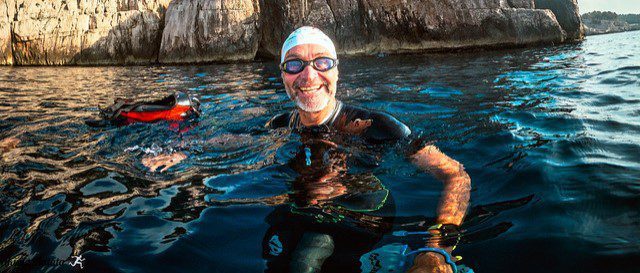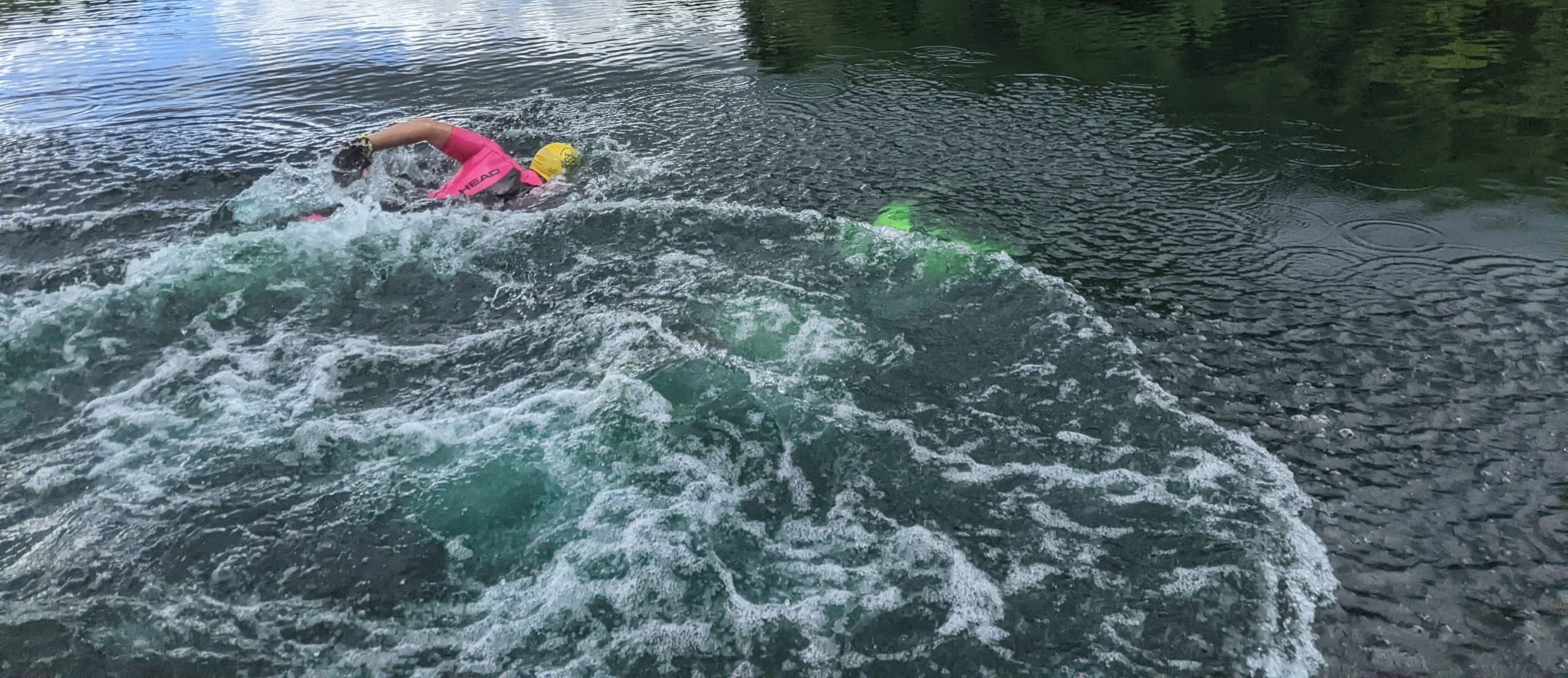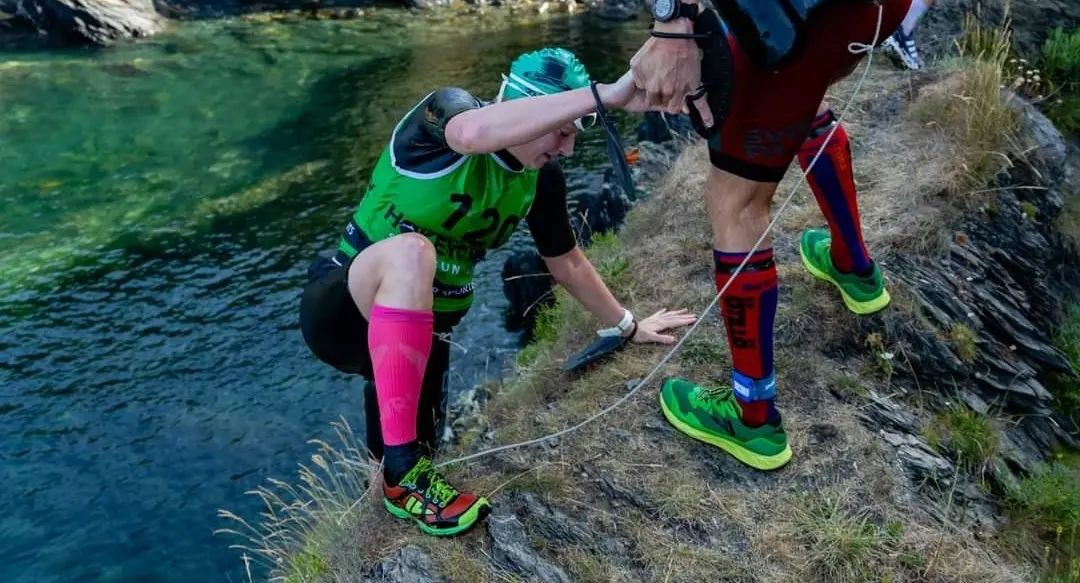From Triathlon to Swimrun: Ditch The Bike And Embrace The Adventure!
This article is a guest post from Olivier Baillet, a four time Ironman World Championship finisher and ÖTILLÖ Swimrun World Championship finisher. Here is his story of becoming a Triaswimrunner (a triathlete and a swimrunner). Olivier offers world-class swimrun coaching to athletes of all abilities with Beyond The Line.

1. Lets start with swimming
The biggest obstacle for a runner or a cyclist to become a triathlete is often swimming. Indeed, if you don’t have a background in swimming, you had to learn how to swim better and more efficiently. Your legs used to sink, your ankle flexibility was poor, you used to trash the water. Later you had to conquer your fear of open water and surmount the terror of mass start. You’ve done all this, you’re a triathlete!
What’s missing then?
In swimrun, you need to learn to swim with your running shoes, but some shoes float relatively well and neoprene calf guards, pullbuoys and wetsuits help a lot (you already knew about the wetsuits, right?). BTW, contrary to triathlon, there is no limitation on the amount of neoprene you can use in swimrun, so many swimrun suits have an extra layer covering the quads, which helps your legs float. Besides, if you have a strong upper body, you can use paddles to gain more traction.

Is it a big deal?
No, just a few sessions with all the gear in open water and a few km/ miles with pullbuoy and paddles in the pool will do. And no, paddles are not compulsory, it’s up to you.
Barrier to entry: low

2. Running on trails with your gear.
Let’s dissect this into two parts.
Running on trails: honestly, if you never run on trails already as a triathlete, you’re losing something. You can run more hours and more mileage on trails than on the road without getting injured. Granted, the risk of falling or spraining an ankle on trails exists, but it is in my opinion preferable to the damage done by the impact of constantly pounding the tarmac. I will assume then that you are already running on
trails, even occasionally.

Running with gear on: you must run with a wetsuit on, but a decent swimrun suit is much more running-friendly that a triathlon wetsuit. You must run with your pull buoy, but an elastic tie around one of your thighs or around your waist where you can position your pull buoy while running helps make you forget this piece of equipment, which weights nothing BTW.
Barrier to entry: low
3. Combining swimming and running in alternate (also known as swimrun!)
C’mon, you’re doing it with three sports already. There is a ‘but’, though. Do not underestimate the trickiness of doing multiple changes of sport, as it is actually one of the main sources of mental and physical stress there is in swimrun. Can you imagine 24 runs and 23 swims? 46 transitions!!
That’s what the World Championship in Sweden is about. And then, don’t expect a nice mat at the entry and exit of each swim, the swim-to-run and run-to-swim environment are almost always rough. In that sense, it is a big change from triathlon.

So what to do?
Train for it. You have been doing bike to run bricks, now it’s time to do multiple swim-to-run-to-swim-to-run (repeats).
Barrier to entry: medium
4. Cost
I’m walking on eggs with this one as not everybody has the same acquisitive power so I’m not gonna say it’s a cheap sport. Instead, I’d say that an entry-level swimrun wetsuit is usually cheaper than a triathlon equivalent and cheaper still, you can always start with a triathlon wetsuit and cut the legs. You can also acquire
a basic neoprene suit in any surf and diving shops to begin practicing.

Obviously, if you live in a warm climate, your triathlon racing suit, preferably one piece, is all you need. You already have running shoes so this is not even a topic: I race on Asics flats, Hoka, and Salomon, anything goes. You already have goggles and a bright swim cap. If you train and race in a duo, you may want to opt for using an elastic
tether, dirt cheap. Thus, you do have to acquire a few minor things, but you can keep it to a minimum cost.
Barrier to entry: low
5. You can be a Team or a Solo participant
The face of swimrun has recently evolved. It used to be a sport exclusively made for duos, where the two athletes in a team were not allowed to be separated by more than 10m at any given time.

It is now possible to race solo, removing the biggest barrier to entry in my opinion: find a partner of relatively similar abilities
who can train and race with you.
Barrier to entry: low
Training and racing conditions:
In swimrun, athletes are definitely more exposed to mother nature than in triathlon. Let’s say that it’s the same difference as between a trail run and a marathon: it’s more rough, but you expect it. That’s probably what attracts many triathletes to swimrun: people long for contact with nature, and a good challenge running on slippery rocks in wet shoes and swimming in seaweeds with paddles is more refreshing than riding 180k in aero position looking at an endless horizon of tarmac… at least for some of us.
Barrier to entry: it depends on your mindset
In summary
You hopefully get the picture: a triathlete is a potential swimrunner. It’s mainly a question of being attracted to it and putting the work to make it happen. Swimrun will give you unparalleled adventures and a sense of freedom in boat loads. Triathletes never relinquish in front of adversity, though. Why do I say that? Because I am also a Triaswimrunner, with a foot in each camp, so I know what both tribes are good at.

If you want to be helped transitioning from triathlon to swimrun, Olivier Baillet @beyondthelinecoaching is your coach: four-time Ironman World Championship finisher, Swimrun World Championship finisher, full-time endurance sports coach since 2014.
olivier@beyondthelinecoaching.com
www.beyondthelinecoaching.com



